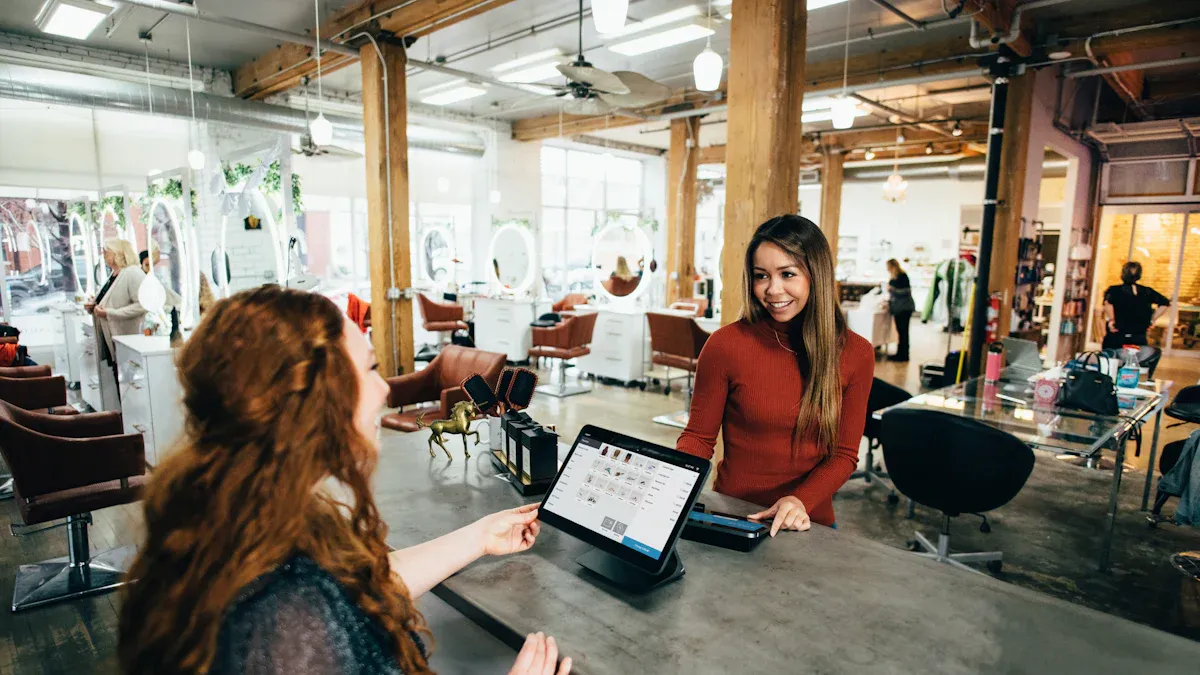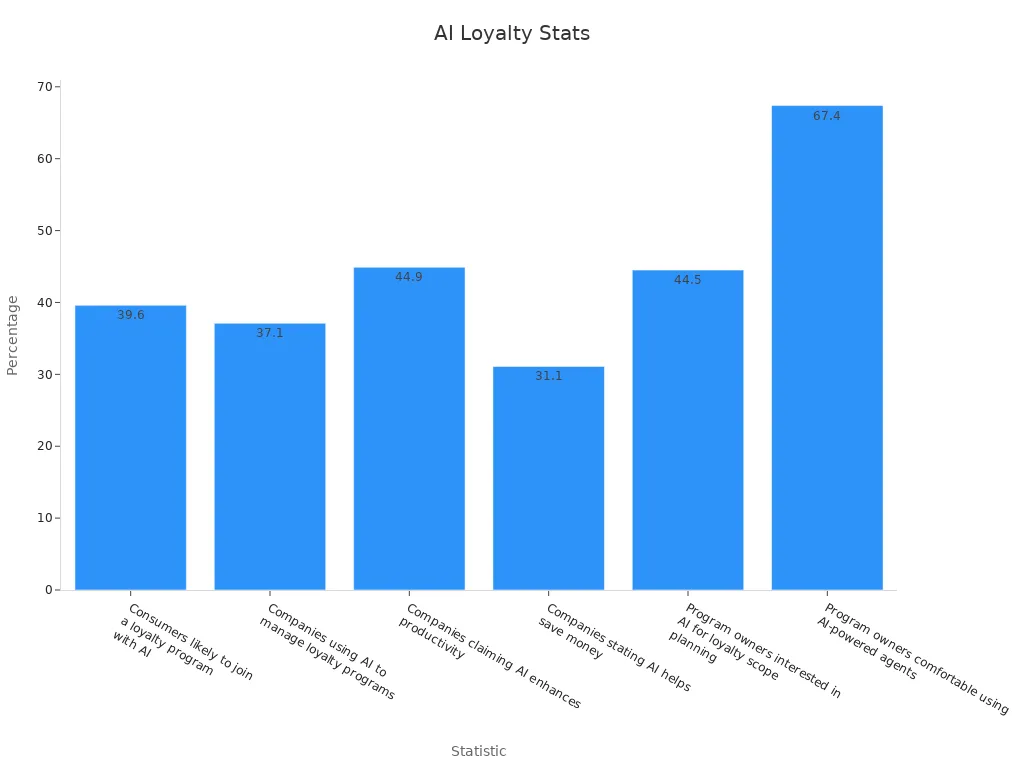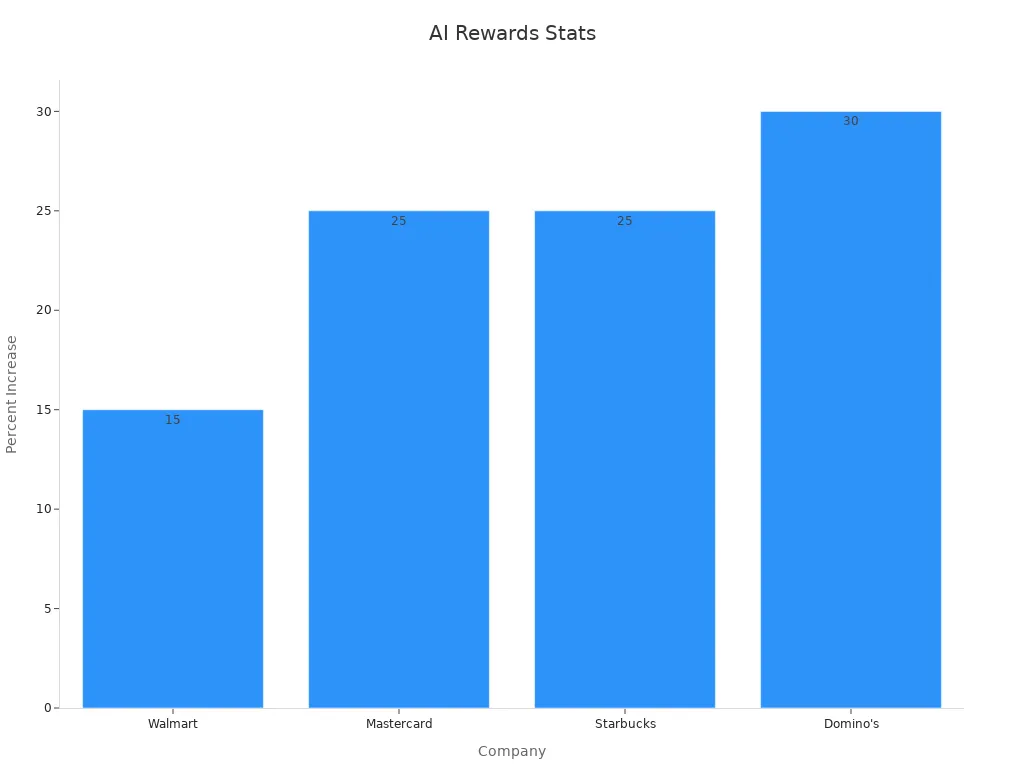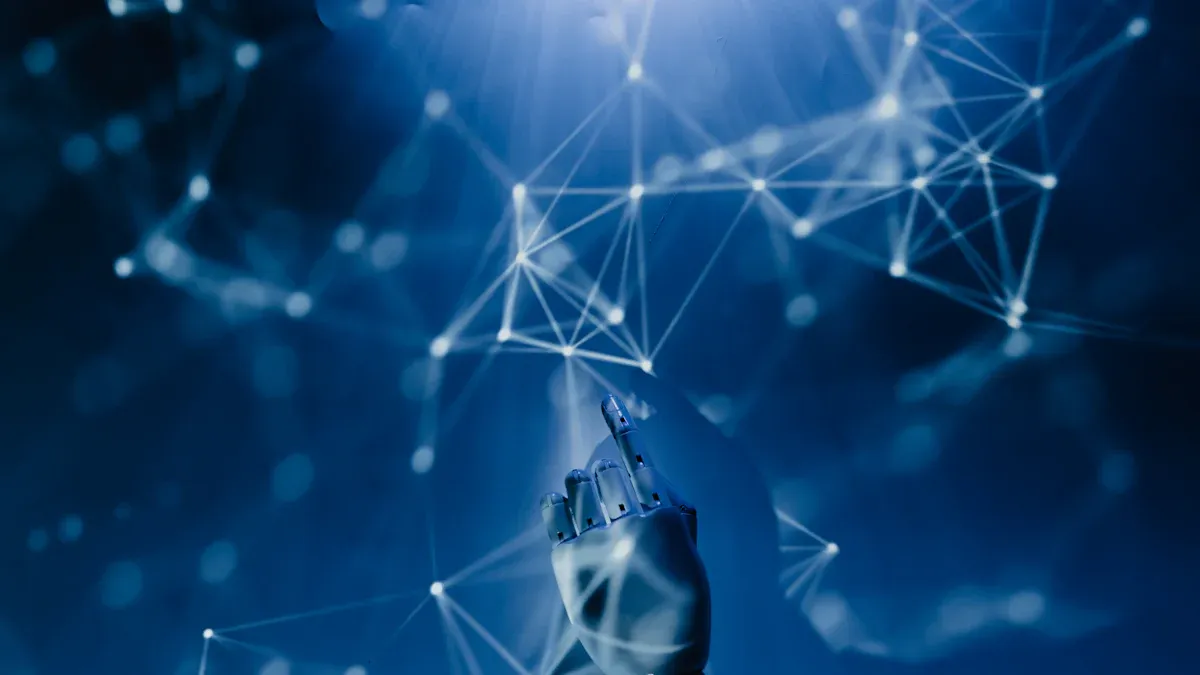Using AI to Create Content for Loyalty Programs

Imagine a world where loyalty programs feel made just for you. That’s what AI can do. Artificial intelligence changes loyalty by making content personal and smart. For example, companies using AI keep 25% more customers and get 184% more email opens. Why does this happen? AI matches every interaction to what you like, making it fun and rewarding. Personalized ads work six times better than regular ones. It’s clear—AI isn’t just a tool; it’s a big change for customer loyalty and engagement.
Key Takeaways
AI makes loyalty programs more personal, so customers feel special. This helps keep them interested and returning often.
AI creates changing content, leading to more email opens and interest. Businesses notice better customer interactions with this approach.
Predictive tools help companies learn what customers like. They can give rewards people really want, making them happier and more loyal.
Personalizing in real-time improves shopping, making customers feel important. This makes them want to shop and spend more.
Using good data and checking AI often is important. It keeps loyalty programs useful and meeting customer needs.
The Role of AI in Loyalty Programs

Dynamic Content Creation
AI is changing how companies make loyalty program content. Instead of boring messages, businesses now send exciting, custom ones. Imagine getting an email that feels written just for you. That’s what AI does. It studies customer data, like what you buy and like, to create messages that connect.
For example, BuzzFeed uses AI to make quizzes and articles about popular topics. This has made users more interested. Similarly, Company A saw 30% more people open their emails after using smart tools. These examples show how AI can improve customer experiences.
Here’s how companies benefit from AI-made content:
Company | How They Use AI | Results |
|---|---|---|
Company A | Used smart tools for email campaigns. | |
Company B | Added AI content suggestions to their website. | 25% more user interest |
BuzzFeed | Creates quizzes and articles about trending topics with AI. | Big rise in user engagement |
The Washington Post | Uses Heliograf to write news stories automatically. | Better news coverage |
Creating dynamic content isn’t just about emails or posts. It’s about making customers feel special. When they feel special, they stay loyal.
Personalization at Scale
Making things personal is now a must. But how do you do this for thousands of people? AI makes it possible. It handles lots of data, finds patterns, and gives each customer a unique experience.
For example, AI can suggest products based on what you’ve looked at online. It can also recommend rewards you’ll love. People use AI-picked rewards 70% of the time, much more than old methods. This makes customers happy and loyal.
Here’s why AI is great for personalizing loyalty programs:
It handles tons of data easily.
It finds patterns to give better offers.
It keeps quality high as your business grows.
With AI, loyalty programs feel personal, even for huge customer groups.
Predictive Analytics for Customer Insights
Knowing your customers is key to loyalty. AI-powered predictive analytics helps you do this. It looks at past data to guess future actions. This helps you make smart choices. For example, you can spot unhappy customers and win them back.
One company used predictive tools to improve email engagement. They got 40% more people to open targeted emails. This doesn’t just boost interest—it gets real results. By guessing what customers want, you can give them rewards they’ll love.
Here are ways AI uses predictive analytics in loyalty programs:
Method | What It Does |
|---|---|
Finds how likely a customer is to act a certain way. | |
Customer Segmentation | Groups customers by similar traits for better marketing. |
Linear Regression | Predicts how much value a customer will bring over time. |
Decision Trees | Uses a tree-like model to guess outcomes based on customer actions. |
Clustering | Groups similar customers for targeted marketing. |
Predictive analytics doesn’t just help you know customers—it helps you meet their needs. When you do, they trust and stick with you.

AI in loyalty programs isn’t just a trend. It’s a big change. With AI, you can make cool content, personalize at scale, and learn about your customers. These tools don’t just improve loyalty programs—they make them amazing.
Applications of AI in Loyalty Programs
Tailored Rewards and Offers
Think about getting a reward made just for you. That’s what AI does in loyalty programs. It looks at what you like, buy, and do. Then, it creates rewards that match your interests. This makes you feel special and helps businesses succeed.
Big companies like Walmart and Starbucks use AI for rewards. Here’s how it helps them:
Company | Improvement Area | Percentage Increase |
|---|---|---|
Walmart | Keeping Employees | |
Mastercard | Employee Happiness | 25% |
Starbucks | Employee Satisfaction | 25% |
Domino's | Boost in Sales | 30% |

These results show how custom rewards improve loyalty programs. When rewards feel personal, customers stay loyal and return often.
AI-Driven Customer Segmentation
Not all customers are alike. Treating them the same can hurt loyalty. AI helps group customers by their habits, likes, and spending. This way, businesses send the right message to each person.
AI uses smart tools like RFM analysis and K-means clustering. Here’s what they do:
Methodology | What It Does |
|---|---|
RFM Analysis | Groups customers by how often and how much they spend. |
K-means Clustering | Sorts customer data into useful marketing groups. |
Outlier Detection | Removes odd data to make better customer groups. |
With these tools, businesses create messages that feel personal. Did you know 70.6% of brands now group customers for loyalty campaigns? This change boosts loyalty and keeps customers interested.
Real-Time Personalization
AI makes personalization even better with real-time changes. Imagine shopping online and seeing suggestions based on what you’re doing now. That’s real-time personalization. It makes every moment feel special.
This method has clear benefits:
Benefit Type | What It Does |
|---|---|
Higher Customer Value | Happy customers stay longer and spend more. |
Better Engagement | Real-time suggestions keep customers interested. |
Less Customer Loss | Personal touches stop customers from leaving. |
Smarter Operations | AI focuses on important customer needs first. |
Real-time personalization creates moments customers remember. It’s not just about meeting their needs—it’s about surprising them.
Benefits of AI-Powered Loyalty Programs

Better Customer Engagement
AI makes customer engagement smarter and more personal. It studies lots of data to learn what customers like. This helps create experiences that feel special and on time.
For example, AI groups customers by their needs using micro-segmentation. This lets businesses send messages or rewards that match each group. Rewards that fit what people like make them feel important. Predictive tools also guess what customers might want next. This keeps them interested and coming back.
Fun fact: AI-powered personalization makes customers feel like VIPs, boosting happiness and loyalty.
Stronger Retention and Loyalty
Customers stay loyal when they feel understood. AI helps by giving rewards and experiences that match their preferences. Studies show personalized programs can raise retention by 5%. This is huge since keeping customers is easier than finding new ones.
AI also makes customers spend more. Loyal customers spend 67% more when they feel connected to a brand. By using AI, businesses can create unique programs that keep customers happy for a long time.
Benefit | What It Means |
|---|---|
Higher Retention | Personalized programs can boost customer retention by 5%. |
More Spending | Engaged customers spend 67% more with personalized loyalty programs. |
Better Brand Image | A focus on customers builds a positive brand reputation. |
Smarter Rewards | AI ensures rewards are both attractive and cost-effective for businesses. |
Smarter Marketing Strategies
AI doesn’t just help loyalty programs; it improves marketing too. Starbucks uses AI to suggest products based on what you buy and where you are. This has made customers more loyal and engaged.
Another example is a bakery-cafe chain. They used Google Cloud to improve their loyalty program. With tools like predictive insights, they made customer experiences more personal. This saved money and added $11 million in yearly revenue.
AI helps businesses focus on what works best. It creates content that connects with customers. It’s not just about selling—it’s about building strong relationships.
Challenges of Using AI in Loyalty Programs
Data Quality and Accuracy
Good data is key for AI in loyalty programs. If data is messy, AI can mess up. For example, a chatbot might give wrong answers if it learns from bad info. That would annoy customers, right? Bad data can also make AI unfair. It might give rewards to some people but skip others.
Security is another big deal. If customer data isn’t protected, hackers could steal it. This would break trust with your customers. Sometimes, AI makes guesses based on wrong data. These mistakes can hurt loyalty and make customers leave.
To fix this, focus on keeping data clean and safe. Check your systems often to make sure they’re fair and accurate.
Ethical Considerations in AI
AI is strong, but it must be used responsibly. It’s important to make sure AI treats everyone fairly. If it’s biased, some groups might miss out on rewards. That’s not just unfair—it’s wrong.
Following rules is also tricky. Governments have strict laws about using AI. Small businesses often struggle because their old systems don’t work well with AI.
What’s the fix? Check your AI tools often and let people review them. This helps keep your loyalty programs fair and honest.
Balancing Automation with Human Touch
AI can do a lot, but people still matter. Customers like talking to real people, not just machines. If you use too much AI, your program might feel cold and push people away.
The trick is to mix both. Let AI handle simple tasks, like sending rewards or sorting customers. Then, let your team handle personal connections. For example, a person can help when AI can’t solve a problem. This mix keeps your loyalty program friendly and effective.
Tip: Always ask, “Does this feel personal?” If not, add a human touch.
Best Practices for AI in Loyalty Programs
Setting Clear Goals and Objectives
Before using AI in loyalty programs, make a clear plan. Without goals, it’s like traveling without a map—you’ll get lost. Start by deciding what you want to achieve. Do you want more loyal customers, better rewards use, or higher engagement? Clear goals help you track progress and stay focused.
Here’s a simple checklist to follow:
Set measurable goals, like raising customer retention by 10%.
Group your audience to create better rewards and messages.
Give new members quick perks to grab their interest.
Build emotional connections, not just reward-based ones.
Use customer data to make offers personal.
Keep the program easy to understand and use.
Collect feedback often and make improvements.
When you set clear goals, your loyalty program works better and feels more personal.
Investing in Quality Data and Tools
AI needs good data to work well. Better data makes AI smarter and more useful. Spending on quality data and tools isn’t optional—it’s necessary. Imagine building a house with broken tools. That’s what happens with bad data.
Big companies like Starbucks and Amazon show how this works. Starbucks uses its Deep Brew AI to study customer likes, creating personal rewards and loyalty. Amazon’s recommendation system increases sales by suggesting products people want.
Here’s how good data and tools help:
Understand customer feelings using sentiment analysis.
Get instant insights with automated reports.
When you choose the right tools, your loyalty program becomes smarter and more effective.
Monitoring and Optimizing AI Performance
AI isn’t something you can set up and forget. You need to check how it’s working regularly. Watching performance helps you see what’s good and what needs fixing. Use numbers like retention rate, churn rate, and reward use to measure success.
For example, tracking your Net Promoter Score (NPS) shows if customers will recommend your brand. If the score drops, it’s time to adjust. Engagement numbers, like email opens and clicks, show how well your program connects with users.
Here’s a table of key metrics to track:
Metric | What It Tracks |
|---|---|
Retention Rate | How many customers stay loyal over time. |
Churn Rate | The percentage of customers leaving the program. |
Redemption Rate | How often rewards are used. |
Net Promoter Score (NPS) | How likely customers are to recommend your brand. |
Customer Lifetime Value (CLV) | The total value a customer brings during their time with your business. |
Engagement Metrics | Includes email opens, clicks, and time spent on loyalty pages. |
By tracking these metrics, you can improve your AI and keep your loyalty program running smoothly.
AI is changing loyalty programs in amazing ways. It makes customer experiences more personal, smarter, and fun. With AI, businesses can guess what customers want, reward good actions, and stop them from leaving.
Personalization is key. A study says 53% of experts think it’s the top loyalty trend for 2024. AI-powered suggestions already inspire 60% of marketers to use smarter tools. But here’s the warning—brands that don’t improve could lose 80% of their customers due to boredom.
AI use is growing in many industries:
Statistic | Value | Description |
|---|---|---|
60% | Brands focusing on Customer Lifetime Value (CLV) | Building long-term relationships. |
58% | Companies using personalized methods | Personalization matters most. |
43% | Gamification adoption rate | Fun, interactive experiences are popular. |
As AI grows, it can boost loyalty and business success endlessly. But using it wisely is important. Keep data clean, act fairly, and mix automation with human care. When done well, AI loyalty programs can help you connect with customers and build strong bonds.
FAQ
What does AI do in loyalty programs?
AI helps make loyalty programs better. It studies data to guess what customers like. It suggests rewards and keeps users interested. This makes programs more fun and useful.
How does making things personal help loyalty?
Personal touches make customers feel special. When rewards match what they like, they stay loyal. It feels like the program is made just for them.
Can small businesses use AI for loyalty programs?
Yes, small businesses can use AI too. There are cheap tools to study customer data and create custom rewards. You don’t need a lot of money to see big results.
Is using AI in loyalty programs safe?
AI is safe if businesses protect customer data. Secure systems and privacy rules build trust. Checking often keeps things fair and correct.
How do I start using AI in my loyalty program?
Start with clear goals. Pick tools that match your needs. Collect good data and test small changes first. Grow as you see success.

